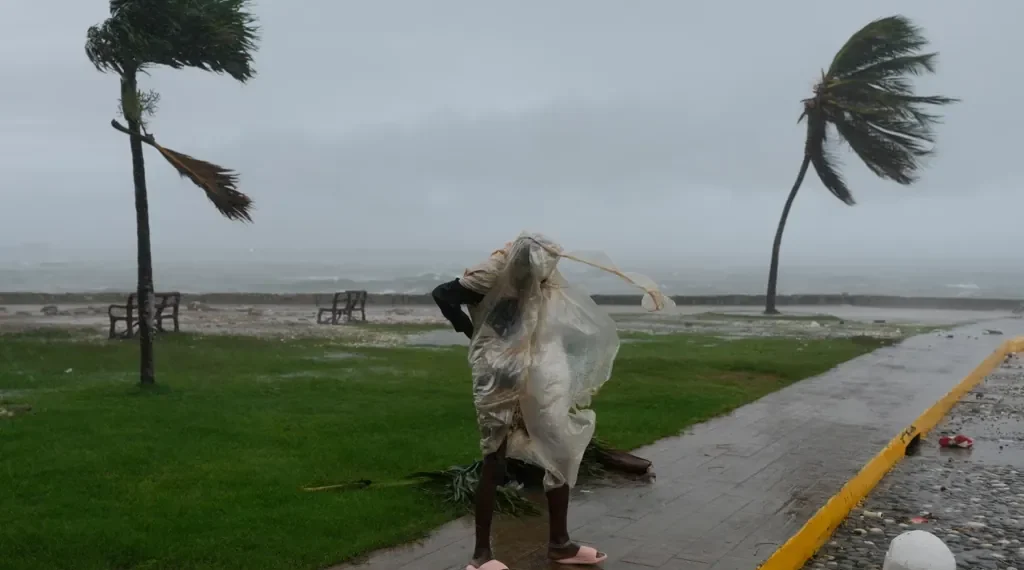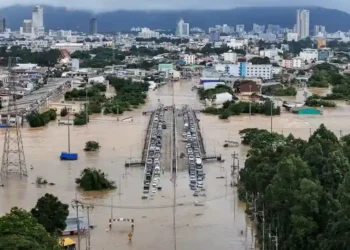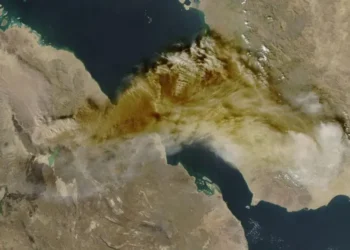Hurricane Melissa, one of the most powerful Atlantic storms ever recorded, slammed into Jamaica on Tuesday with sustained winds of 185 mph (295 kph), unleashing torrential rain, massive flooding, and landslides across the island. The Category 5 hurricane—tied among the strongest in Atlantic history—has already claimed at least seven lives across the Caribbean and left extensive destruction in its wake.
Jamaica faces catastrophic damage
Melissa made landfall near New Hope in southwestern Jamaica and is expected to cut diagonally across the island before exiting near St. Ann Parish in the north, according to the U.S. National Hurricane Center (NHC) in Miami. The storm has left entire parishes under water, toppled trees, blocked roads, and caused widespread power outages.
Desmond McKenzie, deputy chairman of Jamaica’s Disaster Risk Management Council, reported that the southwestern parish of St. Elizabeth “is under water,” with similar devastation in Clarendon. “Almost every parish in the country is experiencing blocked roads, damaged utility poles, and severe flooding,” he said.
Four major hospitals have sustained damage, and one facility lost power completely, forcing the emergency evacuation of 75 patients. Officials also confirmed that at least three families in Black River remain trapped by rising floodwaters, awaiting rescue once weather conditions improve.
Prime Minister Andrew Holness acknowledged the overwhelming scale of the disaster. “There is no infrastructure in the region that can withstand a Category 5,” Holness said. “The question now is the speed of recovery. That’s the challenge.”
Cuba prepares for impact
As Melissa moves north-northeast at roughly 8 mph (13 kph), Cuba is now squarely in its path. Forecasters expect the storm to make landfall late Tuesday or early Wednesday in eastern Cuba, potentially delivering up to 20 inches (51 centimeters) of rainfall and a dangerous coastal storm surge.
Cuban authorities have already begun mass evacuations. Beatriz Johnson Urrutia, president of the Provincial Defense Council in Santiago de Cuba, confirmed that more than 281,000 residents have been relocated to 101 evacuation centers or nearby relatives’ homes. Coastal communities have been fully cleared, with only emergency personnel remaining to safeguard infrastructure.
Cuba’s National Institute of Hydraulic Resources reported that several reservoirs are nearing capacity, with five already releasing water in anticipation of the storm’s arrival.
Climate change intensifies hurricane behavior
Meteorologists say Hurricane Melissa’s explosive growth was driven by abnormally warm ocean temperatures linked to global climate change. Over the weekend, the storm’s wind speed doubled in less than 24 hours—a phenomenon known as “rapid intensification.”
Climate scientists note that Melissa is the fourth Atlantic storm this year to undergo such a rapid escalation, reflecting a worrying trend as oceans absorb more heat from the atmosphere. The National Oceanic and Atmospheric Administration (NOAA) and the World Meteorological Organization (WMO) have warned that higher sea surface temperatures are fueling stronger and more destructive tropical systems.
Danger on the ground: fear and curiosity
Despite repeated warnings from Jamaican authorities to stay indoors, some residents ventured outside during the storm’s peak. In Portmore, 15-year-old Gavin Fuller admitted he was curious about the hurricane’s power. “I’ve never seen a Category 5 storm, so I couldn’t help but imagine what it must be like,” he said.
Fuller’s friend, 16-year-old Demario Smith, joined him in the high winds. “Yes, I do believe that the storm is dangerous, but I just wanted to see for myself what it is doing,” he said. Local officials have condemned such behavior, urging residents to remain sheltered until conditions stabilize.
A long road to recovery
By Tuesday night, Hurricane Melissa’s eye had moved off Jamaica’s northern coast, centered roughly 50 miles (80 kilometers) east-northeast of Montego Bay and 160 miles (260 kilometers) southwest of Guantánamo, Cuba. Sustained winds remained at 125 mph (205 kph), according to the NHC.
Emergency services across Jamaica are expected to begin large-scale rescue and recovery operations once winds subside. The Jamaican government has requested assistance from international partners, and humanitarian organizations, including the Red Cross and UN disaster response teams, are on standby to provide relief aid.
As the Caribbean braces for further impact, meteorologists caution that the remnants of Hurricane Melissa could still pose a threat to the Bahamas and southern Florida later this week.
This article was rewritten by JournosNews.com based on verified reporting from trusted sources. The content has been independently reviewed, fact-checked, and edited for accuracy, neutrality, tone, and global readability in accordance with Google News and AdSense standards.
All opinions, quotes, or statements from contributors, experts, or sourced organizations do not necessarily reflect the views of JournosNews.com. JournosNews.com maintains full editorial independence from any external funders, sponsors, or organizations.
Stay informed with JournosNews.com — your trusted source for verified global reporting and in-depth analysis. Follow us on Google News, BlueSky, and X for real-time updates.














